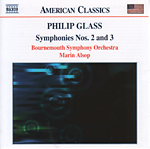Philip Glass’ symphonies are unique among the composer’s output for their relative harmonic and thematic complexity. Listeners put off by Glass’ endlessly repeated arpeggios will be relieved to find scant evidence of them in these works. Instead, like his opera Beauty and the Beast, Glass spins long melodic lines that go through many harmonic permutations before they are inevitably repeated. Thus, Symphony No. 2’s first movement creates an air of expectation, something that Glass maintains through shifting instrumental timbres and stimulating dynamic contrast as the movement builds, Bolero-like, to a grand climax. After the soothing, somewhat meditative sonic environment of the slow movement, the finale breaks in with its agitated dance rhythms. This movement has the least harmonic variety of the three, and listeners unsympathetic to Glass’ method may experience repetition fatigue.
Symphony No. 3 is almost radical in its use of traditional forms, including chaconne and rondo. Glass replaces the expansiveness of the earlier work with a highly concentrated thematic process that packs substantially more musical ideas into only slightly more than half the former symphony’s duration. The second movement is particularly interesting, with its compound meters and hints of Bartók. Marin Alsop brings her long familiarity with the composer’s music to her convincing performances of both works, although she faces strong competition in the No. 3 from Glass specialist Dennis Russell Davies, who leads a slightly more compelling rendition with the Stuttgart Chamber Orchestra (type Q1712 in Search Reviews). For its part, the Bournemouth Symphony plays keenly, maintaining enthusiasm and rhythmic exactitude even in the more repetitious passages. Naxos’ warm and spacious recording presents the music with a compelling impact. [12/03/2004]
































